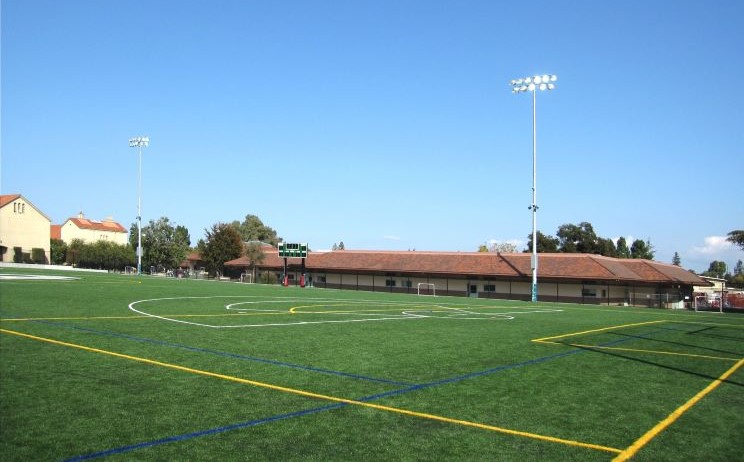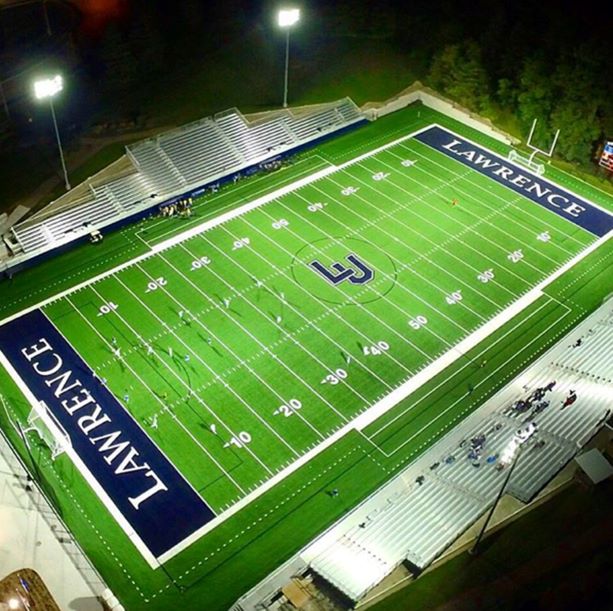By Mary Helen Sprecher
No offense to good fences, but good sports field lighting also makes good neighbors. In some cases, it makes much better neighbors.
“With today’s solid state, direct lens lighting technology, spill, glare and glow (more commonly grouped together as light pollution) are significantly less problematic than yesterday’s technology,” said Charles Dawson of Tencate. “The old days of finding the local football game by following the glow in the sky have been eliminated.”
There is no doubt that sports lighting has evolved over the years. Incandescent lights were used first on fields and were followed by floodlights. High-intensity discharge (HID), also known as metal halide, came along a few decades later, but it wasn’t until after the millennium that pro sports began using LED.
When field managers consider updates to their overall facility, it is all but expected that they will look at their old HID lights – long the standard in many outdoor installations – with a critical eye and consider replacement with LED systems.
“When properly designed, LED systems reduce glare and spill by up to 95 percent over HID systems, while allowing superior uniformities and centerline lighting on the playing surfaces,” said Dawson.
Another advantage of LED is its ability to be remotely controlled; many systems can be used via a mobile app that allows lights to be dimmed or shut off completely at a certain time. It is also far more energy efficient; some vendors tout the annual savings as 75% or more.

For those considering a new system, the following should be taken into account:
Design: Lighting systems should be designed in accordance with the facility. Lighting designs should conform to local building, electrical and safety codes. Other design considerations should include:
- Energy efficiency: The fixture selection process should include an analysis of the energy efficiency to determine the most efficient light sources and fixtures. Lighting controls such as motion sensors, automated control systems and dimming of fixtures should be considered to reduce energy consumption.
- Fixture locations: Fixture locations should be determined to allow accessibility for maintenance and emergency equipment.
- Television or internet broadcast: If broadcasts will take place at a facility, it is best to consult with local broadcasters to define lighting requirements.
- Verification of light levels: After the installation of the fixtures, it is recommended that the lighting levels be measured on the playing surface and recorded. Remember that many sports (and even various skill levels within sports) will necessitate different amounts of light. Measurements will need to be taken with a calibrated light meter. Readings should be compared to the calculated values and adjustments made as needed to achieve the required light levels and uniformities.
LED is not equal to HID: Many field managers assume HID and LED design characteristics are interchangeable; however, they are not. Talk with a lighting contractor about the options.
Uniformity: “Uniformity is king when reviewing photometric (lighting layout) designs,” said Dawson. “Uniformity is the smoothness of the light over the surface, and measures corresponding points of light to eliminate hots spots or dark spots. High-wattage fixtures are not a positive, especially on smaller fields. For example, if a baseball infield needs 5,000 watts of light to meet necessary light levels, installing two 2,500-watt fixtures or four 1,250-watt fixtures is not an optimum design strategy. By installing eight 600-watt fixtures, the design team is given more aiming angles to better distribute light.”
Be strategic: “When exploring lighting, especially in complexes and smaller venues, lower-wattage fixtures that allow more aiming angles in the design create superior uniformity and lighting performance,” added Dawson. “If a design is presented that offers low fixture counts with high-wattage fixtures, you immediately know uniformity will suffer due to limited lighting distribution points, and an outage on any single fixture will hamper the ability to continue activities at the facility. The well-versed manager should demand multiple lighting distribution points, which in turn guarantees maximum uniformities and performance.”
Replacement of old poles is not necessary: Here’s some good news. You don’t necessarily need to tear down your poles or rip up your field.
“The best LED systems in the world can be installed on existing poles and cross arms, regardless of the previous supplier of the HID system,” said Dawson. “These retrofits drastically reduce the upfront cost and allow a far better return on investment for the owner.”
That is, however, assuming the current poles are in good shape; rust and other degradation can complicate installation. Consult with an electrical contractor to ascertain that there are no pre-existing problems.
Don’t fall for internet ads touting cheap lighting systems: While it is certainly possible to purchase equipment online – and often at bargain-basement prices – that equipment is often manufactured and shipped from outside the country and usually does not offer the buyer any customer support once the product arrives.
Keep in mind that inexpensive equipment may have limited functionality and low product manufacturing standards. This may lead to a need to have repairs done (at your cost) by a local electrical contractor, and ultimately to replace the whole system sooner rather than later. The wiser investment is made by purchasing a domestically manufactured sports-specific system that is backed by a reputable company with references from users who can speak to the customer service experience before, during and after installation.
While LED lighting does constitute an investment, cutting corners does not result in the best outcome. A good company will provide a quality system backed by a warranty and supported by sales staff that can answer questions.
And while you’re thinking of cost: Remember to do a full evaluation of your needs and what you stand to save by investing in a new LED system. A life-cycle cost analysis can determine the effectiveness of a potential LED lighting retrofit, and should take into consideration capital costs, maintenance costs and operations costs.
At the end of the day (literally), a good lighting system is one of the factors that lends itself to the overall experience at a facility, whether on the field or in the stands. It brightens up the field, and provides better visibility and a higher resolution for photos and videos. Additionally, it extends the playing day and allows any facility to host more games and create a better economic return for the owner.
No matter what the use of the field, however, it is essential to research various lighting vendors and check references prior to deciding upon any system. Ask questions, talk to colleagues and find out what they have to say about the systems they decided to purchase. Even better, go to a game and see it in action. It may be the deciding factor. But always do your research.
“The industry offers a variety of options and design characteristics in the LED market,” said Dawson. “With a significant savings in energy cost and the elimination of costly HID lamp or ballast changes, the switch to LED can be a net positive on the owner’s budget.”
Mary Helen Sprecher wrote this article on behalf of the American Sports Builders Association (ASBA). Full information on design, construction, amenities and accessories for running track can be found in the ASBA publication, Sports Fields: A Construction and Maintenance Manual. For more information, visit www.sportsbuilders.org.


